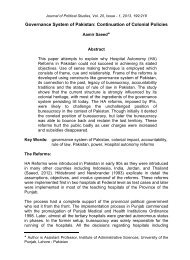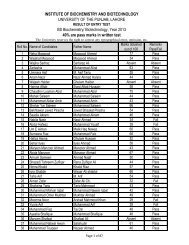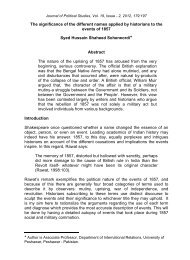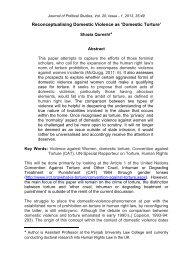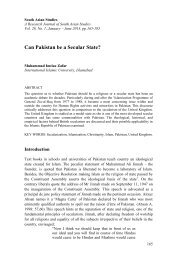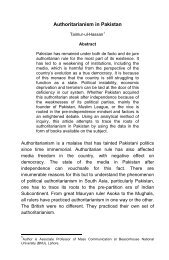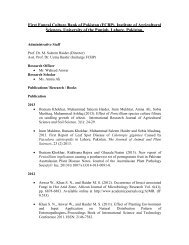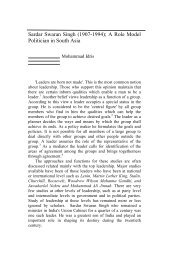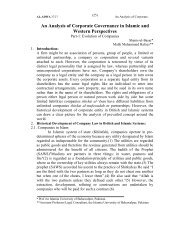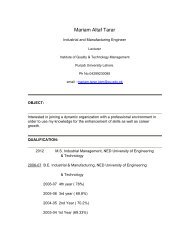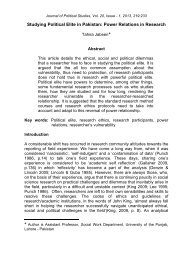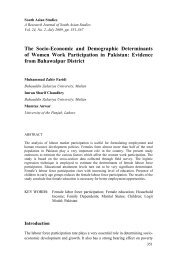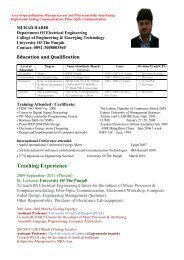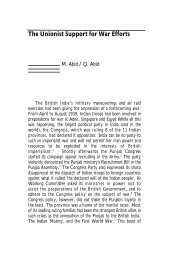pakistan geographical review 1954 - University of the Punjab
pakistan geographical review 1954 - University of the Punjab
pakistan geographical review 1954 - University of the Punjab
Create successful ePaper yourself
Turn your PDF publications into a flip-book with our unique Google optimized e-Paper software.
Cost <strong>of</strong> Tractor Cultivation.-It is reckoned that cultivating with a Tractor<br />
using a Cultivators or Disc plough and doing <strong>the</strong> work better than a pair <strong>of</strong><br />
bullocks would be about Rs. 5 per acre whereas bullock cultivation would cost<br />
at least Rs. 8. If slow speed Light Diesel Tractors are used <strong>the</strong> cost would be<br />
under Rs. 3 per acre. There is no doubt Tractor Cultivation is cheaper than<br />
bnllock cultivation so long as wheat prices are over Rs. 5 and cotton over<br />
Rs. 15 per maund.<br />
Displacement <strong>of</strong> Labour.-It is reckoned that on a unit <strong>of</strong> 300 acres with<br />
Tractor Cultivation we would require at most 12 men instead <strong>of</strong> 36 employed<br />
with bullock cultivation. This means a very serious displacement <strong>of</strong> labour or<br />
tenants and hence <strong>the</strong> use <strong>of</strong> Tractors on settled areas must be very gradual.<br />
The excess labour can gradually be absorbed by industrialisation, -but this<br />
problem is a serious one.<br />
111echanisatior; by Co-operative Societies.--It IS sometimes argued that in<br />
settled areas <strong>the</strong> best way <strong>of</strong> mechanising is through a (a-operative Society <strong>of</strong><br />
Farmers. If 20 tenants owning <strong>of</strong> cultivating between <strong>the</strong>m a unit <strong>of</strong> 300 acres<br />
decide to co-operate, <strong>the</strong>y can keep a 25 H.P. to 35 H.P. Tractor fully occupied,<br />
but <strong>the</strong>re will be no work for at least 66% <strong>of</strong> <strong>the</strong>m as 33% can easily do all that<br />
is necessary except at harvest time and cotton picking time when more temporary<br />
labour is required. Only one out <strong>of</strong> every eight pairs <strong>of</strong> bullocks will<br />
need to be kept, so excepting for milking cows or buffaloes very little fodder is<br />
required-say at most 20% <strong>of</strong> <strong>the</strong> cropped area. Thus <strong>the</strong> increased cropping<br />
under cash and human food will be 100/85 X 13= 15'3% increase. It may be<br />
pointed out that in o<strong>the</strong>r mechanised countr-ies ego in U. K. <strong>the</strong> horse is completely<br />
eliminated. In <strong>the</strong> early stages <strong>of</strong> mech auisat ion in Pakistan it is<br />
advisable to keep one pai. uf cattle ptr 100 acres for miscellaneous levelling,<br />
sowing smail vegetable pluts and o<strong>the</strong>r iuiscellaneous works.<br />
O<strong>the</strong>r advantages<br />
<strong>of</strong> mechanization.<br />
1. Saving <strong>of</strong> water in irrigation. As in a block <strong>of</strong> 300 acres <strong>the</strong> cotton<br />
crop will be generally in large blocks <strong>the</strong> irrigation water will be running in<br />
channels<br />
in <strong>the</strong> crop and losses by percola tion are sa ved.<br />
2. The cultivation is better than that done by bullocks and occasional<br />
deep ploughings even once in 2 or a years gradually improve fertility.<br />
3. Operations can be done in time. It is possible to work a Tractor<br />
24 hours a day if necessary. In <strong>the</strong> case <strong>of</strong> wheat harvesting this <strong>of</strong>ten leads to<br />
saving <strong>of</strong> grain from shedding.<br />
30



